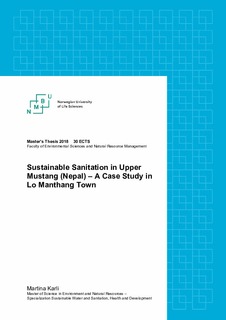| dc.description.abstract | In Upper Mustang, one of Nepal's highest and most remote regions, sanitation infrastructure is undergoing major transitions. The area's inhabitants have traditionally been using dry toilets, perfectly adapted to the semi-arid Trans-Himalayan climate. Excreta are covered with ash from dung fires and reused on fields – the only fertilizer apart from animal manure in a place where about 90% of the people rely on subsistence agriculture and pastoralism. In recent years, however, guesthouses and schools have started building water toilets, which is problematic due to inadequate or non-existing wastewater treatment, posing a health risk and contaminating scarce water resources. Since living conditions in the area are very simple and health services limited, sustainable sanitation is crucial to avoid far-reaching problems.
A charity school in Upper Mustang's capital Lo Manthang is in the midst of these challenges: The school's dry toilets can no longer be used due to a lack of moisture-absorbing materials after switching from dung to gas as a cooking fuel. Meanwhile, the single functioning pour-flush toilet which was built instead is insufficient for the 40 resident students and staff and also causes unsolved issues with blackwater disposal. The objective of this thesis was to develop a sustainable sanitation system in cooperation with the school, aiming at a solution that would be considerate of the environmental conditions and available resources, culturally acceptable, affordable, and directed by local needs for long-term viability. In addition, general suggestions for sustainable sanitary improvements in the area are proposed, based on an assessment of the local context through a combination of social and natural science methods.
Among different options, the school chose to build five urine-diverting dry toilets, henceforth providing separate facilities for girls, boys and staff. When collecting urine and feces separately, only small amounts of amendments are needed to dehydrate and sanitize the pathogen-containing feces before reuse as soil conditioner on fields. The practically sterile, nutrient-rich urine can be applied to crops, for example to increase vegetable production. All materials and expertise for this technology are available in Nepal. For successful implementation, the school will need professional guidance and training of all users. Proper operation and maintenance will require a high degree of commitment, as will the safe handling and reuse of excreta, for which cooperation with farmers might be necessary. Furthermore, to improve the school's sanitary environment holistically, water supply and hygiene measures are essential: The current lack of running water will be addressed with a water storage system, three taps for hand-washing, three showers, and an infiltration trench for safe graywater disposal. The water quality of the town's public supply was found to comply with national standards. Through hygiene education and teachers as role models, students are likely to adopt hygiene habits for life.
For Lo Manthang, an awareness-raising program on the links between water, sanitation, hygiene, health and the environment is recommended, including information on the pros and cons of different sanitary options. Local households are advised to keep using dry toilets, and guesthouses may consider returning to dry sanitation as sewage disposal in leaching cesspools is not a long-term solution. Supplying excreta from dry toilets to farmers to cultivate organic produce could strengthen local livelihoods and serve to promote ecotourism. Clean public toilets, with urine diversion and/or solar dehydration, are suggested to reduce open defecation and demonstrate that dry toilets can look attractive – notions of "modernity" being one of the reasons why half of the local respondents prefer water toilets. However, while most welcome the idea of public toilets, only few would pay a user fee to ensure maintenance. To avoid water pollution, an infiltration system or constructed wetland should be built on the terrace of Lo Manthang to treat graywater – and blackwater if water toilets remain in use. The analyzed soils' hydraulic conductivity is low (2.2-8.3*10-5m/s), but purification will be good thanks to their calcium content sorbing phos-phorus and pathogens. Judging by the area's heterogeneous layered deposits, infiltration rates at other sites or greater depths will be higher. Effluent from a constructed wetland can be reused for irrigation.
Research challenges included constraints on finances and time in Upper Mustang. Moreover, stakeholder engagement at the school – though so crucial to create ownership – did not happen to the desired extent, probably related to differing expectations and priorities as well as limited experience with the participatory approach on all sides. In Lo Manthang, representative surveys will need to assess various stakeholders' attitudes towards ecological sanitation and wastewater treatment. The elaboration of designs and management schemes will require feasibility studies and further site investigations. However, the most important is the local people's initiative, involvement, and cooperation with sanitation experts. | nb_NO |

